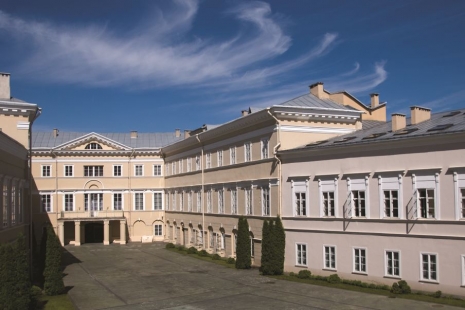“Though each piece and the series of works by Žygimantas Augustinas are underpinned by different and clear concepts, they are all linked by his investigation into uncertainty. This state of mind most likely is familiar to everyone, and the artist offers to take an unorthodox, witty look at our time and place. I believe that each visitor to the exhibition will find their own answers to these issues and will also relish in the exquisitely skillful manner of the painter,” Akvilė Anglickaitė, curator of the event, places it into context.
“Contemporary artists invited into the exhibition rooms of Vilnius Picture Gallery usually have to meet high expectations, while their original take on the past is among the most important criteria. Just like the artwork by Patricija Jurkštaitytė, hosted by the gallery several years ago, the painting by Žygimantas Augustinas exceeds these expectations. His compelling artwork brims with witticism, his technical virtuosity is married with a perceptive look at our present time and at the past still there. Few can resist his skills in self(irony). I am positive that this exhibition will become a major art event and will help those new to Vilnius Picture Gallery to discover the venue,” Dr Aiste Bimbiryte, director of Vilnius Picture Gallery of the LNMA is excited about the coming exhibition.
What is uncertain?
At the exhibition, the painter confronts his viewers with the question “Who am I?” Is there anything more real besides one’s self, one’s own body, expressions, one’s own shadow? The answer to these questions might become a guarantee, a pledge of sorts, yet his paintings start to obliterate the comfortable knowledge about our identity.
The artist lends his skin, muscles, his expressions first, to contemporary everyday characters, later – to historical figures. His real self seems to dissolve, by incarnating into others, the self-images multiply until finally that unique certain image disappears. According to the curator, there is imagination, play, laughter, irony and the feeling that certainty is, indeed, not even welcome.
The ancient Greeks knew a partial solution to the questions that are impossible to answer. Upon entering the Delfi temple where the mythical characters and simple mortals went for answers from the oracles, one was met by three inscriptions: “know yourself”, “nothing’s too much” and the third one, which clearly linked certainty to misfortune, but its meaning has been debated for several millennia.
Contrary to the ancient Greeks, uncertainty in the contemporary world has acquired a negative meaning, and it is being banned from all fields of life. “Guarantee” is a literal translation of the third inscription of the Delfi temple, and is used in the title with a tinge of irony.
Rewriting history – in hope to create a better world?
In one of the spaces of the display, the artist proposes to the visitors to relocate to 16th-century ducal palace. The artist does not create an imitation, nor a copy of the past. He designs a parallel reality, at the same time pondering on techniques of creating the impression of a credible image.
To extend Žygimantas Augustas’s portrait gallery, the artist follows in his footsteps and assumes the role of rewriting history. He claims “that the love story of Žygimantas Augustas and Barbora Radvilaitė wanted a different ending”. Queen Barbora died an early death, leaving Žygimantas Augustas, the last male offspring of the Jagiellon dynasty heirless. The artist undertakes to fix what he deems a failure of history, creating portraits of the son of Žygimantas Augustas.
The artist uses craniometric points of the scull of Žygimantas Augustas and Barbora Radvilaitė to calculate the landmarks of a hypothetical son’s head, then transfers these proportions into a portrait of the heir. To strengthen the credibility of these images, he paints one of the portraits in pigment, made my Simona Rukužaitė from a stone from the foundation of the Palace of the Grand Dukes of Lithuania.
The artist explores these historical narratives, to quote him, “for the sake of creating a better and more perfect world”. He is not interested in facts, but in the very act of rewriting them.
Curator Akvilė Anglickaitė
Architecture by design studio MOA
Designer Vilmantas Žumbys
Coordinator Gabija Kasparavičiūtė-Kaminskienė
Project supported by Vilnius Academy of Art
Exhibition lenders: NOEWE, MO Museum, Ieva Burbaitė, Algirdas ir Remigijus Gataveckai, Dalia Gruodienė, Monika Krikštopaitytė, Vilmantas Marcinkevičius, Rūta and Tomas Osencovai, other private collectors





